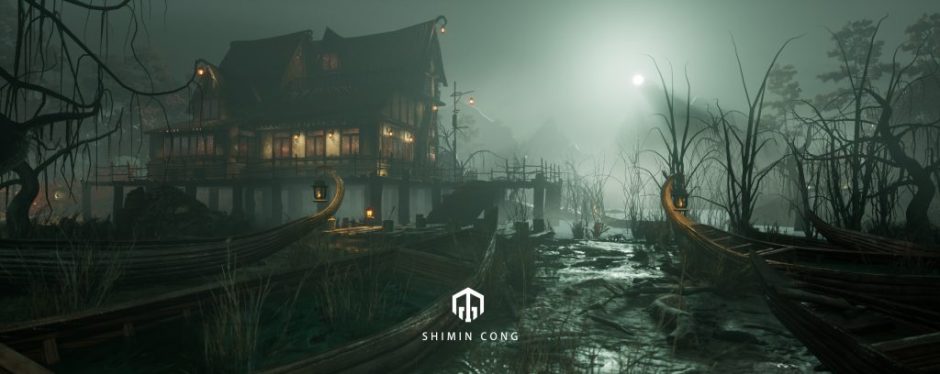This tutorial mainly introduces the Unreal material and lighting system. I think what I learned most in this course is how to learn Unreal correctly. First, I will organize the content of the course. Then introduce the new learning method I got.
WHAT IS A MATERIAL?
- It is essentially an asset applied to a mesh to control its visual look
- In its simplest form, think of it as”Paint” with various properties such as Color and Finish
- A Material defines how light interacts with the surface it is applied to.
WHAT IS PBR?
- Unified lighting and shading system
- Better approximation of light &materials physical interaction
Intuitive and consistent
Physically accurate
Uses real-world physical measurements
- PBR is a combination of:
Materials
Lighting
Exposure
BASE COLOR (ALBEDO)
- Flat color without specularity or shading
- Linear RGB(Vector 3)values between 0~1
- Avoid pure black(0) and pure white(1)as they don’t really exist in nature.
METALLIC
- Grayscale value that ranges from 0~1
- Most common usage is on or off(1 or 0)
- When on(1),it yields a 100% specular reflection

ROUGHNESS
- Grayscale value that ranges from 0~1
- Ranges from smooth, mirror-like surface(0)to a rougher matte surface (1)
- Unlike with Metallic,you are encouraged to fine-tune the Roughness value between 0 and 1 or use a bitmap to that effect.

SPECULAR
- Grayscale value that ranges from 0~1
- A good rule of thumb is to set the Specular value to 0.5 and fine-tune the Roughness value instead
- In some cases,you may decide to edit the roughness value or use a bitmap to that effect.
SUPPORTED FORMATS
Uncompressed
- BMP
- TGA (Alpha)
- PSD
Compressed
- PNG (Simple Alpha)
- JPG
- DDS
- HDR
GUIDELINES
- Textures should always be a power of 2
16×16 all the way to 8192×8192 in size
- Textures do not have to be square,as long as they are a power of 2
16×128 or 2048×1024 or 2×4096 are all acceptable examples
- Textures can affect streaming and memory management
- High-frequency textures can cause anti-aliasing artifacts

IMPORTING TEXTURES
- Use the Import button or simply drag & drop from Windows Explorer
- Textures are converted to .uassets
- You can open a texture in the Texture Editor with a simple double-click
- Here,you can change the Compression Settings if you need to
- You can also enable or disable the linear color space (sRGB)
OVERVIEW
- A Material is a combination of textures and mathematical calculations to define how light reacts to a surface
- Materials define shading attributes such as color, roughness, metalness, etc..
- You use textures to drive shading attributes(such as roughness for example)
- Materials are built using the Material Editor
LIGHTING TERMINOLOGY
- Direct Lighting is light that falls onto a surface without any interference. The light travels directly to the surface and that surface receives the full color spectrum of the light.
- Indirect(or bounced)Lighting is lighting that has been reflected by other surfaces nearby.As light bounces off these surfaces,light waves are absorbed or reflected based on surfaces properties and passed on to the surface you are looking at. Thus,indirect lighting contributes to the mood and overal ight intensity.
- Shadows happen when when Unreal Engine takes a snapshot of a mesh actor from a light’s POVand projects that information onto another mesh actor on the opposite side.
STATIC vs. DYNAMIC LIGHITNG
- Baked (Static)Lighting is pre-computed/rendered lighting. Baked lighting is created using Unreal’s Ligthmass radiosity baker. Similar to rendering lighting with VRay, Corona etc. It is used to create high quality indirect lighting using light and shadow maps.Baked lighting cannot be altered at run-time, but has little impact on
- Real-Time (Dynamic)Lighting is lighting that is updated each frame.It is fully dynamic and can be moved around and modified at run-time. It has no global illumination component (only direct light).It is also expensive to use (affects real- time performance).
- Unreal can use both static and dynamic lighting.For Arch/Vis projects where assets are typically stationary, baked(static)lighting is mostly used.
LIGHT TYPES
- Directional (Sun) Light
- Point (Omni) Light
- Spot Light
- Rect Light
- Sky Light
HDRI/lmage-Based Ambient Light
LIGHIT PROPERTIES
- Intensity
Point & Spot Lights-unitless, candelas,lumens
100 watts = 1600 lumens
Directional (Sun) Lights-lux
- Temperature
- Indirect Lighting Intensity
- Attenuation
- Source Radius / Source Angle
- Inverse Square Falloff
- IES Profiles
LIGHT MOBILITY
- Static
Baked indirect and direct lighting
Cheapest to use
- Stationary
Baked indirect lighting
High-quality direct lighting &shadows
Limited use (max.4 overlapping lights)
Highest quality/Medium performance hit
- Movable
Fully dynamic light & shadows
Highest performance cost
no indirect lighting
WHAT IS LIGHTMASS?
- Offline Gl Renderer
- Performance cost is virtually zero at run-time
- The building process gets longer as your scene become more complex.
- Lightmass is built using Unreal Swarm Agent
- Adjust Lightmass Settings at the Actor level or more globally in the World Settings panel.
LEARNING METHOD
In this lesson, I learned a new learning method-learning through Unreal’s official resource package. In this official document, the performance and function of each node or material are explained in detail. Although after reading many explanations, some of the knowledge will be forgotten by me.
